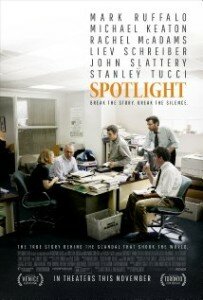The compelling “Spotlight” is a process movie, from cover-up to expose.
 It is less about child molestation by members of the clergy over decades, than about how the story was investigated by reporters at the Boston Globe.
It is less about child molestation by members of the clergy over decades, than about how the story was investigated by reporters at the Boston Globe.
In showing them doing their job – for which the paper won a Pulitzer Prize – it shows how every civic and spiritual institution in the city was tainted by the crimes.
Remarkably, by my count, only three priests are even seen, one of them Cardinal Bernard Law who helped arrange transfers of pedophile priests and silenced victims with non disclosure clauses attached to out of court settlements.
But as portrayed in the film the pained testimony of several now-grown victims, whom no one would listen to over the years or who were reluctant to come forward, will bring you to tears.
It is all seen through the properly cluttered prism of daily newspaper life – mono-focused personalities in wrinkled clothes, eating junk food, working on their own time at home or in cluttered newsrooms with harsh fluorescent lighting and newspapers stacked on desks. All that’s missing is election night pizza.
“Spotlight” is by Tom McCarthy, writer-director of “The Station Agent” and an actor who portrayed a corrupt reporter in “The Wire.” McCarthy co-wrote the screenplay with Josh Singer, who previously wrote the Julian Assange film “The Fifth Estate.”
It is set in a city so institutionally incestuous that power brokers call each other by their first names and golf together and so insular that 60% of the newspaper’s subscribers are Catholic.
Marty Baron the new editor, played by Liev Shreiber, was not only the paper’s first Jewish editor but as an outsider – he came to the paper from Miami and is now at the Washington Post – he was able to see more objectively what others in the city and at the paper took for the status quo.
At his urging Spotlight, the investigative team headed by Michael Keaton in the film – methodically peeled back layers of the onion; old clips lead to sources who led to other sources and other resources – revealing a pattern dating back decades and ultimately involving several hundred priests and a thousand victims.
As part of Globe’s investigative team an excitable Mark Ruffalo has the fiery outrage of Joe Rossi in “Lou Grant,” and affects a nasal vocal pitch so distinctly neutral it sounds like he’s doing an accent.
A reporter played by Rachel McAdams still goes to mass with her grandmother. And the reporter played by stage and TV actor Brian D’Arcy James has a half-way house for pedophile priests down the block from where he lives with his kids and tapes a note on the refrigerator warning them never to go there.
Milwaukee gets a mention during the credits in a list of other cities where clerical abuse took place.
In 2002, at about the same time that the stories were being reported in Boston, the Milwaukee archdiocese formed a task force to look into handling of clerical abuse cases here. This September, a federal judge approved a $21 million settlement between the Archdiocese and nearly 600 clergy abuse victims.
Also, the 2012 documentary “Mea Maxima Culpa: Silence in the House of God,” by Alex Gibney, explored clerical abuse of students at St. John’s School for the Deaf, in St. Francis.
Today such stories are so sadly familiar that “Spotlight” offers little insight into the particulars. But that’s because it is really about how newspapers once were, before they were stripped of resources and personnel.
***1/2 Three and one half stars
With Mark Ruffalo, Michael Keaton, Rachel McAdams, Brian D’Arcy James, Liev Schreiber, John Slattery, Stanley Tucci, Jamey Sheridan. Produced by Blye Pagon Faust, Steve Golin, Nicoloe Rocklin, Michael Sugar.
Written by Tom McCarthy, Josh Singer. Directed by Tom McCarthy.
Approximate running time: 128 minutes. Rated R: language, sexual references.
Tags: Boston Globe, clerical abuse, Spotlight Posted by